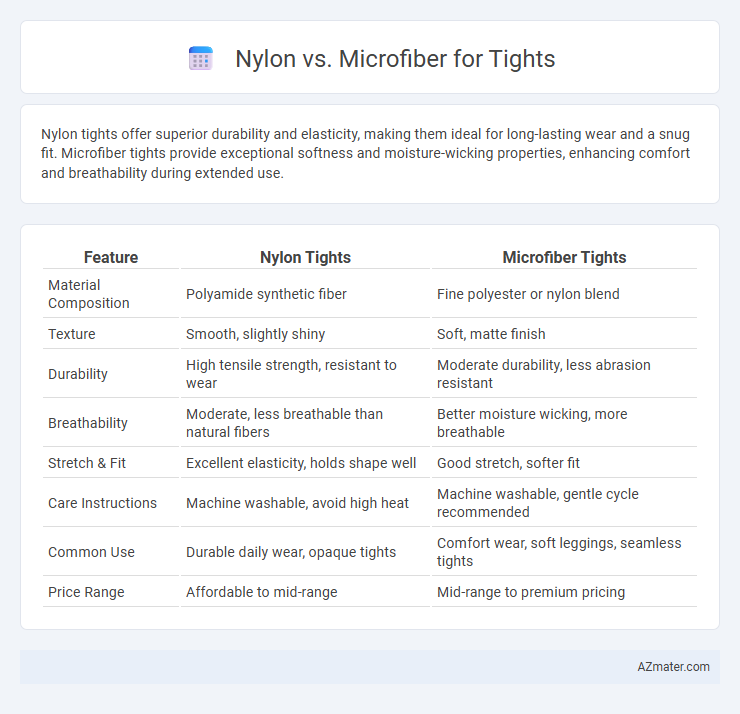Nylon tights offer superior durability and elasticity, making them ideal for long-lasting wear and a snug fit. Microfiber tights provide exceptional softness and moisture-wicking properties, enhancing comfort and breathability during extended use.
Table of Comparison
| Feature | Nylon Tights | Microfiber Tights |
|---|---|---|
| Material Composition | Polyamide synthetic fiber | Fine polyester or nylon blend |
| Texture | Smooth, slightly shiny | Soft, matte finish |
| Durability | High tensile strength, resistant to wear | Moderate durability, less abrasion resistant |
| Breathability | Moderate, less breathable than natural fibers | Better moisture wicking, more breathable |
| Stretch & Fit | Excellent elasticity, holds shape well | Good stretch, softer fit |
| Care Instructions | Machine washable, avoid high heat | Machine washable, gentle cycle recommended |
| Common Use | Durable daily wear, opaque tights | Comfort wear, soft leggings, seamless tights |
| Price Range | Affordable to mid-range | Mid-range to premium pricing |
Introduction: Nylon vs Microfiber Tights
Nylon tights are renowned for their durability, elasticity, and smooth finish, making them a popular choice for everyday wear. Microfiber tights offer superior softness, breathability, and moisture-wicking properties, ideal for comfort during extended use. Both materials provide varying levels of opacity and stretch, catering to different preferences and needs in hosiery.
Material Composition and Structure
Nylon tights are crafted from synthetic polyamides known for their strength, elasticity, and smooth finish, providing durability and a sleek appearance. Microfiber tights consist of ultra-fine synthetic fibers, often a blend of polyester and polyamide, delivering a softer, more breathable texture with enhanced moisture-wicking properties. The denser weave and finer fibers of microfiber offer superior comfort and flexibility compared to the typically smoother and more resilient nylon fabric.
Comfort and Texture Comparison
Nylon tights offer a smooth, silky texture with strong elasticity, providing a snug and supportive fit that enhances overall comfort during wear. Microfiber tights feature a finer, softer fiber blend that delivers a lightweight, breathable feel with superior moisture-wicking properties, reducing skin irritation and overheating. When comparing comfort and texture, microfiber excels in softness and breathability, while nylon stands out for durability and stretch retention.
Durability and Longevity
Nylon tights offer superior durability due to their high tensile strength and resistance to abrasion, making them ideal for frequent wear and extended use. Microfiber tights, composed of ultra-fine synthetic fibers, provide excellent elasticity and softness but may be more prone to pilling and wear over time compared to nylon. Choosing nylon ensures longer-lasting tights with better resistance to snagging and stretching, while microfiber excels in comfort but may require more gentle care to maintain longevity.
Breathability and Moisture Wicking
Microfiber tights exhibit superior breathability compared to nylon, allowing better air circulation and reducing heat buildup during wear. Nylon, while durable and stretchy, tends to trap moisture against the skin, whereas microfiber's fine fibers enhance moisture-wicking capabilities by efficiently pulling sweat away from the body. This makes microfiber tights an optimal choice for activities requiring consistent dryness and comfort in varying temperatures.
Fit and Stretchability
Nylon tights offer excellent fit and superior stretchability due to their strong, elastic fibers that contour closely to the body, providing a smooth and supportive feel. Microfiber tights excel in softness and flexibility, offering a lightweight fit that moves comfortably with the wearer while maintaining shape without sagging. Both materials provide good durability, but nylon typically delivers better compression and resilience for a snug, secure fit in tights.
Opaqueness and Appearance
Microfiber tights typically offer superior opaqueness compared to nylon, providing a richer, denser coverage ideal for cooler weather. Nylon tights are known for their glossy finish and smooth texture, enhancing leg appearance with a subtle sheen that highlights skin tone. Microfiber fabric generally produces a matte appearance, resulting in a sleek, uniform look that minimizes shine and creates a more natural leg silhouette.
Care and Maintenance Requirements
Nylon tights require gentle washing in cold water and air drying to maintain elasticity and prevent pilling, while microfiber tights benefit from similar care but are more resistant to snags and running. Avoid bleach and fabric softeners for both materials to preserve fiber integrity and color vibrancy. Storing tights in a separate drawer or using a mesh laundry bag during washing extends their lifespan by reducing friction and damage.
Ideal Uses and Occasions
Nylon tights excel in durability and moisture-wicking properties, making them ideal for athletic activities, daily wear, and colder weather due to their insulating capabilities. Microfiber tights offer superior softness and breathability, perfect for formal occasions, office settings, and mild climates where comfort and appearance are prioritized. Both materials provide stretch and fit, but nylon suits active lifestyles while microfiber complements style-focused ensembles.
Conclusion: Which Tights Material Is Best?
Microfiber tights offer superior softness, breathability, and moisture-wicking properties compared to nylon, enhancing comfort during extended wear. Nylon tights provide exceptional durability and elasticity, making them ideal for activities requiring high stretch and resilience. Choosing the best material depends on specific needs: microfiber for comfort and everyday use, nylon for durability and performance.

Infographic: Nylon vs Microfiber for Tights
 azmater.com
azmater.com